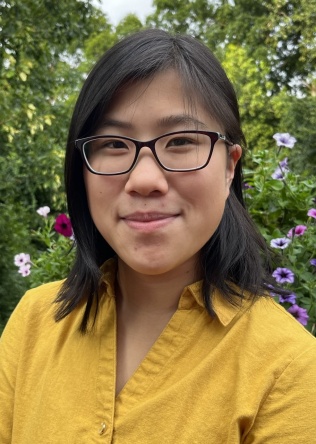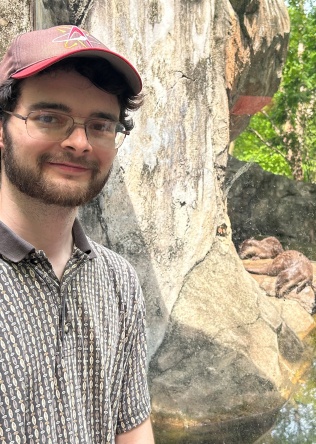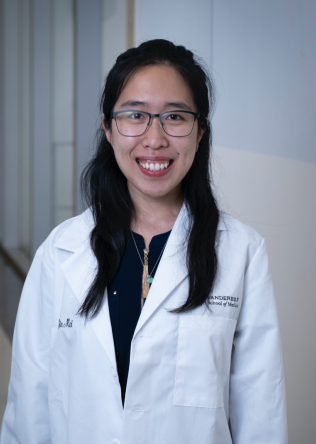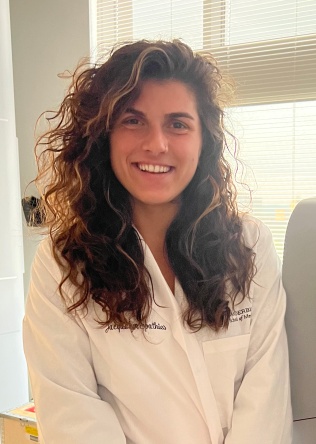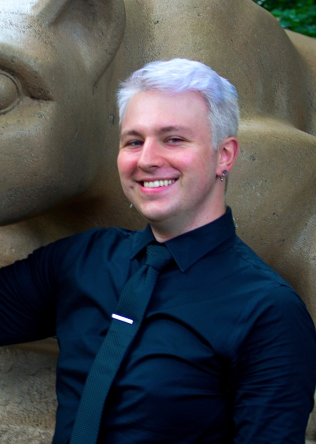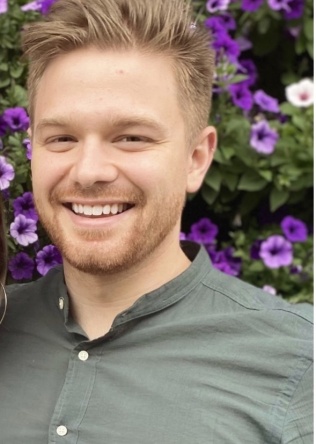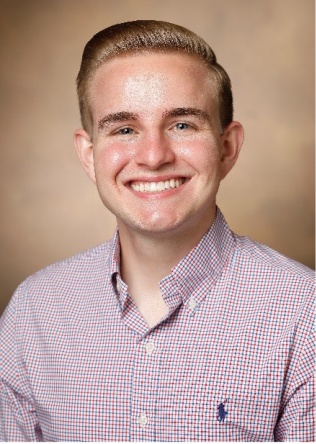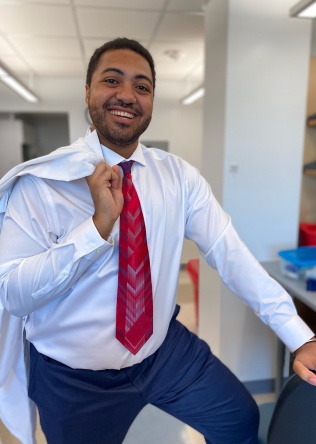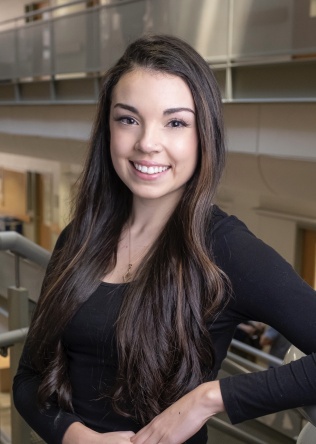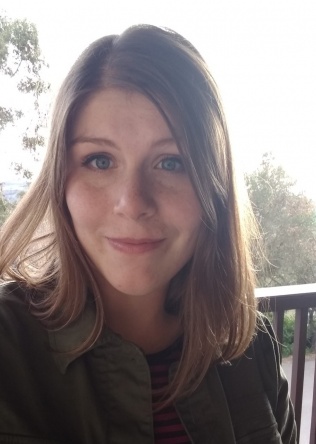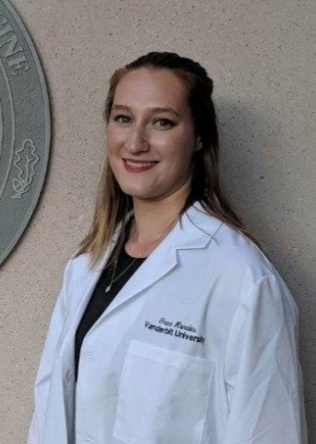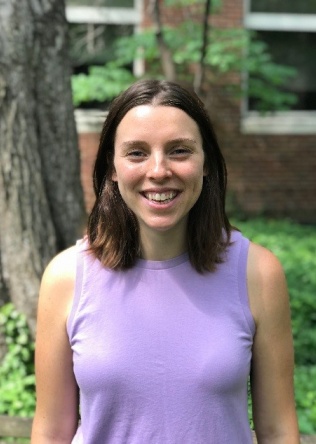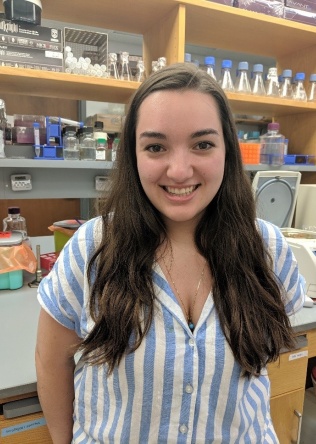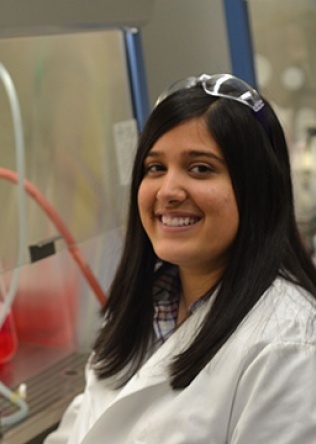First Year CBID Trainees
-
Biofilms are multicellular communities of bacteria that can form on both biotic and abiotic surfaces. Biofilms are particularly challenging to eliminate, as they are encased by a matrix of extracellular polymeric substances (EPS) making them resistant to antibiotic penetration and enabling evasion of the immune response. Given their robust nature, biofilms contribute to several types of infections including urinary tract infections (UTIs). Thus, there is a need to develop novel therapies targeting biofilms.
Previous work in the Hadjifrangiskou lab has focused on characterizing biofilms that form during bladder infection, by uropathogenic Escherichia coli (UPEC), the leading cause of UTIs. Previous studies determined that UPEC respire aerobically during biofilm expansion in the bladder. This led to the investigation of the terminal quinol oxidases of the electron transport chain. E. coli encodes three quinol oxidases: one heme copper oxidase, cytochrome bo, and two bd-type oxidases, cytochrome bd and cytochrome bd2. The oxidases support respiration by coupling electron transfer from quinol to molecular oxygen with the generation of a proton motive force (pmf) that is used for ATP production. Recent work determined that loss of cytochrome bd altered UPEC biofilm architecture, enhanced susceptibility to antibiotics, and rendered the mutants immotile. This occurred despite compensatory expression of cytochrome bo and without defects in flagellar assembly. The defect in motility was attributed to reduction of respiratory flux in the mutants, which occurred without affecting ATP production. Therefore, the current hypothesis is that in addition to its role in respiration, the pmf generated by cytochrome bd can energize other processes like motility. My project aims to address this by 1) determining the mechanism of how cytochrome bd influences motility and 2) evaluating the potential of fungal products that inhibit cytochrome bd as adjuvants to current antibiotics.
Mentor: Maria Hadjifrangiskou, Ph.D.
-
Val Jackson-Hundley
Research: Investigating cellular responses to ROS stress in UroPathogenic E. coli using High-Content ImagingVal was born and raised in Santa Fe, New Mexico. He received a B.S. in Microbiology (with a minor in History) from the University of California, San Diego in 2020. He went on to work in Dr. Stephen Leppla’s lab at the National Institutes of Health, studying toxin gene regulation in Bacillus anthracis. Val joined the Bratton lab in 2023 through the IGP program.
Mentor: Ben Bratton, Ph.D.
-
Jia Mei
Research: Antibiotic tolerance in S. aureusJia Mei is a graduate student in the Department of Pathology, Microbiology, and Immunology. She entered the IGP program in 2022 and joined Dr. Jim Cassat's lab in 2023 to study mechanisms of antibiotic tolerance in Staphylococcus aureus, one of the most common causes of osteomyelitis, or infection of the bone. Notably, treatment failure occurs in around 20% of adult osteomyelitis cases. Although treatment failure is commonly attributed to genetic resistance in pathogens, antibiotic tolerance- the transient ability of a bacteria to survive in lethal concentrations of antibiotic-- remains an important mechanism that warrants further research. The Cassat lab has developed a robust in vivo model that recapitulates antibiotic tolerance in an osteomyelitis model. Further research aims to identify specific host niches and bacterial adaptations that promote tolerance. This work will lead to a mechanistic understanding of the microbe-host interplay in contributing to tolerance, thereby informing future efforts in combating treatment failure.
Mentor: Jim Cassat, Ph.D., M.D.
-
Antiana Richardson
Research: Discovery and Characterization of RNA Quality Control Pathways in Innate ImmunityAntiana is a PhD. Student in the Microbe Host Interaction Graduate Program mentored by Dr. John Karijolich. She is from Kansas City, MO and earned her bachelor’s in biology from Washinton University in St. Louis in 2020. Her undergraduate research focused on the role of nucleic acid modifications in chromosome organization in the model organism Tetrahymena thermophila. After graduating she worked in the Karijolich lab as a Research Assistant for 2 years and started Vanderbilt’s Biomedical PhD program in 2022. Antiana’s current research investigates regulatory RNA mechanisms during infections and immunity.
Mentor: John Karijolich, Ph.D.
-
Jacquelyn is a graduate student in the department of microbe-host interactions. She is originally from the west suburbs of Chicago and graduated from Eastern Illinois University with her BS in biology. Jacquelyn came to Vanderbilt through the 2022 IGP cohort and works in the laboratories of Jeffery Spraggins and Eric Skaar using MALDI-IMS to study molecular interactions within the mucus layer of the intestine. Specifically, Jacquelyn is working to develop novel MALDI platforms for the study of mucosal lipids. Mucus consists of water, glycoproteins, lipids, and electrolytes. Lipids are integral to the hydrophobicity, fluidity, and rigidity of this barrier, and unlike glycoproteins, lipids can be easily influenced based on diet or chemical exposures, increasing their diversity and influence on mucosal barrier function. The influence microbes have on human health can benefit from characterizing the chemical landscape of mucus under different conditions.
Mentor: Jeffery Spraggins and Eric Skaar
Second Year CBID Trainees
-
Jillian Armenia
Research: DNA gyrase as a drug target in pathogenic bacteriaJillian Armenia is a graduate student in the department of Biochemistry at Vanderbilt. Jill earned her bachelor’s degree in biology from Tufts University in Medford, Massachusetts. Her research at Vanderbilt focuses on DNA gyrase as a drug target in pathogenic bacteria such as Mycobacterium tuberculosis, Campylobacter jejuni, Treponema pallidum, and Helicobacter pylori, all of which encode gyrase as their sole type II topoisomerase. Developing a better understanding of how these enzymes function as the only type II topoisomerase in cells as well as characterizing their interactions with current and novel type II topoisomerase-targeting drugs will provide insight into how they can be targeted by antibacterials to overcome antimicrobial resistance.
Mentor: Neil Osheroff, Ph.D.
-
Dante Reyna
Research: Understanding poor fungal host defense in models of hyperglycemiaIn diabetes, poor insulin production or response results in hyperglycemia. Hyperglycemia has been associated with many complications, including an increased susceptibility to skin infections. Among the most common skin infections are those caused by opportunistic fungal pathogens, the most common of which is caused by the dimorphic fungus Candida albicans. Candida Albicans (C.albicans) is a resident member of the normal flora, naturally colonizing the skin, genital, and intestinal mucosa in up to 70% of individuals. In healthy individuals, C.albicans is a resident member of the normal flora in the gastrointestinal tract and mucous membranes. However, endogenous infections from the person’s flora often occur in uncontrolled hyperglycemia. These C.albicans infections present a major public health burden in people with metabolic distress. Despite the high incidence of C. albicans in obese and diabetic individuals, little is known about the process of infection within the diabetic population. Furthermore, a disproportionate incidence rate of C.albicans infections affects African-American and Indigenous populations. In the past, our lab has shown that depletion of macrophages in hyperglycemic mice improved host defense, it is likely that macrophages in diabetic skin are promoting an overwhelming inflammatory response. My project seeks to elucidate the contribution the innate immune system has in C.albicans pathogenesis. This proposal aims to fill gaps in our understanding on chronic hyperglycemia triggers and the unusual inflammatory response during C. albicans infection, leading to tissue destruction, fungal dissemination, and death.
-
Rachael Smith
Research: enhance T cell responses to vaccines and immunotherapiesRachael is a Ph.D. student in the Molecular Pathology and Immunology Graduate Program, co-mentored by Drs. John Wilson and Jeff Rathmell. She is from Spanish Fort, Alabama, and completed her B.S. in Chemistry with a concentration in Biochemistry at the University of Montevallo in 2020. While completing her undergraduate degree, she worked for the CDC and WHO on the Global Burden of Influenza (IcEBErG) Project and studied under Dr. Rajindra Aryal in Dr. Cummings’ Lab at Harvard Medical School, where she investigated Cosmc knockout effect on O-glycosylation of the LDL receptor. Her current research focuses on engineering targeted nanoscale delivery platforms and harnessing multi-adjuvant synergy to enhance T cell responses to vaccines and immunotherapies.
Mentors: John T. Wilson, Ph.D. and Jeffrey Rathmell, Ph.D.
-
Ty Sornberger
Research: Discovery and characterization of monoclonal antibodies to influenza A virus.Ty Sornberger is a graduate student in the Department of Pathology, Microbiology, and Immunology at Vanderbilt University, mentored by Dr. James E. Crowe, Jr. He graduated from Pennsylvania State University in 2020 with a B.S. in Immunology & Infectious Disease and a B.S. in Pharmacology & Toxicology. Afterward, Ty worked in the Pennsylvania State University COVID-19 Testing and Surveillance Center (TASC), running clinical diagnostic tests for SARS-CoV-2 and assisting with research projects involving SARS-CoV-2 and High-Pathogenicity Avian Influenza (HPAI). Ty entered Vanderbilt University through the Interdisciplinary Graduate Program (IGP) in Fall 2021 and joined the Crowe Lab in Spring 2022. His current research focuses on isolating and characterizing human antibodies against influenza viruses.
Mentor: James Crowe, Jr., M.D.
Third Year CBID Trainees
-
Ryan Fansler
Research: Iron homeostasis in the commensal gut microbe Bacteroides thetaiotaomicron in the inflamed gutThe human gastrointestinal tract is home to trillions of microbes collectively termed the gut microbiota. At homeostasis, the gut microbial community provides pivotal functions to human health. However, perturbations such as intestinal inflammation can drive the microbiota towards a perturbed state termed dysbiosis. As dysbiotic microbiota causes and exacerbates diseases in susceptible hosts, factors that prevents the gut microbiota from entering a dysbiotic state or facilitate the reversion to the original equilibrium, such as microbial resilience, are fundamental in maintaining host health. Despite being considered essential for maintaining the stable structure and function of the human microbiome over time, little is known about the mechanisms by which the microbiota remains resilient in the face of perturbations such as intestinal inflammation.
Iron is essential to many biological redox reactions. During episodes of intestinal inflammation, the host immune system sequesters free iron during as a defense against microbial invaders. To survive iron limitation, gut commensals must exert tight control of iron uptake and utilization. However, little is known about how commensals maintain iron homeostasis in the inflamed intestine. My project focuses on elucidating the role of iron homeostasis in the resilience of commensal model organism Bacteroides thetaiotaomicron (B. theta) in the context of gut inflammation. Specifically, I will 1) determine whether iron-sparing response contributes to B. theta fitness in the inflamed intestine and 2) define the mechanisms by which small RNAs regulate iron prioritization in Bacteroides thetaiotaomicron in vitro and in vivo. A better understanding of iron regulation’s role in microbiota resilience may contribute to the rational design of therapeutic interventions for a dysbiotic gut.
Mentor: Wenhan Zhu, Ph.D.
-
Asher Hollenbeak
Research: Directed Evolution of Antibiotic Biosynthetic PathwaysIn the antibiotic discovery process, natural products are oftentimes too large or complicated to be chemically modified without disruption of chemical properties, as is the case in everninomicin, a large oligosaccharide antibiotic synthesized via a 130 step biosynthesis. This prevents the facile generation of natural product analogs in a laboratory setting. My project involves the modification of a known antibiotic, everninomicin, via directed evolution of the proteins in the biosynthetic pathway. The generation of everninomicin analogs will precede the testing of everninomicin analogs for ribosomal binding affinity and increased antibiotic activity towards Gram negative bacteria. This will be the first time a new antibiotic will be synthesized through directed evolution of the biosynthetic pathway.
Mentor: Brian Bachmann, Ph.D.
-
Parker Jamieson
Research: High-Throughput Mapping of Antibody Sequences Against HIV-1 Immunogens After Multivalent VaccinationThe HIV-1 vaccine field has gone through several significant paradigm shifts, with recent years seeing an overwhelming push toward “rational” immunogen design that incorporates information about known broadly neutralizing antibodies (bNAbs), their epitopes on HIV-1 Env, and the bNAb-epitope interactions. A significant challenge that has hindered the development of an effective HIV-1 vaccine is the limited ability to study antibody responses to vaccination. In particular, current approaches for characterizing antibody responses to vaccination are limited in their ability to generate high-resolution antigen specificity information linked to antibody sequence, thus providing an incomplete understanding of the types and specificities of vaccine-elicited antibody repertoires. This issue is particularly pronounced in the context of multivalent vaccines, since it prevents a detailed understanding of cross-specific vs. strain-specific antibody responses to the different components of the candidate vaccine. To address this issue, we recently developed LIBRA-seq, a technology that enables high-throughput mapping of antibody sequence to antigen specificity for a theoretically unlimited number of antigens, from a single next-generation sequencing experiment. Parker’s project will focus on applying the LIBRA-seq technology to the characterization of antibody responses to vaccination with multivalent immunogens. These efforts will lead to new insights into how the human immune system responds to multivalent vaccines that incorporate a cocktail of multiple different HIV-1 strains.
Mentor: Ivelin Georgiev, Ph.D.
-
Elias West
Research: Iron acquisition and homeostasis in C. difficile during infectionElias was born and raised in Omaha, Nebraska. He earned his B.S. in Biology from Loyola Marymount University in Los Angeles, California. Elias joined the Skaar Lab in 2021 through the IGP program, and his project focuses on iron acquisition systems utilized by C. difficile during infection when in competition with the immune system and gut microbes.
Mentor: Eric P. Skaar, Ph.D., M.P.H.
-
Rachael Wolters, DVM
Research: Discovery and characterization of monoclonal antibodies to Influenza B.Rachael Wolters is a graduate student in the Department of Pathology, Microbiology, and Immunology at Vanderbilt, mentored by Dr. James E. Crowe, Jr. She obtained her B.S. in Animal Science from The University of Tennessee at Martin and went on to earn her Doctor of Veterinary Medicine from The University of Tennessee College of Veterinary Medicine, in Knoxville Tennessee. She is interested in the interface of computation and antibody discovery to infectious diseases. She is currently focused on Influenza B antibody discovery.
Mentor: James E. Crowe, Jr., M.D.
Fourth Year CBID Trainees
-
Alexandra Abu-Shmais
Research: Gaining a better understanding of the fundamental rules of antibody-antigen interactionsAlexandra’s project will focus on gaining a better understanding of the fundamental rules of antibody-antigen interactions. Recently our laboratory developed a technology termed Linking B cell Receptor to Antigen Specificity through Sequencing (LIBRA-seq) that enables the rapid identification of antigen-specific B cells. Using this technology, we have successfully identified B cells capable of recognizing antigens encoded within human immunodeficiency virus (HIV), hepatitis C virus (HCV), and influenza virus. LIBRA-seq turns BCR-antigen interactions into sequence-able events using DNA barcoding, antigen-specific B cell sorting and single-cell sequencing. As her primary project, Alexandra will leverage the LIBRA-seq technology to construct a human antibody-antigen atlas with specificity towards antigens from a number of common viral pathogens, such as influenza, respiratory syncytial virus, human metapneumovirus, and others. Due to the continuous exposure every person experiences to infection by or vaccination against these common pathogens, antigen-specific B cells can be identified in virtually anyone. Yet, there is still extremely limited information about the repertoires of B cells that different individuals use to recognize these common pathogens and vaccines. With the application of the LIBRA-seq technology, Alexandra will aim to create a high-resolution “atlas” of antibodies and their antigen specificity, resulting in unparalleled depth of information about antibody-antigen interactions. Identified B cells will be produced as recombinant monoclonal antibodies and tested in various assays to define their structural, functional, and other characteristics. Aligned with the CBID goals, this project will entail a variety of biochemical methods, such as protein purification and binding assays, oligonucleotideprotein conjugation, structural biology, and others, in order to gain novel insights into the fundamental rules of antibody-antigen interactions for a variety of pathogens. Furthermore, the outcomes of this proposal may lead to the discovery of novel antibodies of potential therapeutic or vaccine template interest against biomedically relevant agents of infectious disease.
Mentor: Ivelin Georgiev, Ph.D.
-
Jamisha Francis
Research: The human innate immune protein S100A12 mitigates zinc stress and promotes Group B Streptococcus pathogenesisGroup B streptococcal (GBS) or Streptococcus agalactiae infections are one of the top five leading causes of neonatal mortality, causing chorioamnionitis, fetal infection, neonatal sepsis and preterm birth. GBS colonizes the urogenital and/or the gastro-intestinal tract of about 40-50% of healthy women in the United States. Innate immune cells like neutrophils respond to GBS and deposit antimicrobial molecules like S100A-family proteins. S100A12 or Calgranulin C is a calcium binding proinflammatory protein that is secreted by granulocytes. Under conditions of low metal availability, S100A12 inhibits GBS growth via zinc chelation, a result that was reversed by the addition of exogenous zinc. In conditions of high zinc availability, S100A12 mitigates zinc stress in GBS and promotes biofilm formation on abiotic and biotic surfaces. Conversely, the addition of zinc represses bacterial biofilm formation on polystyrene, gestational membranes and the instrumented fetal membrane on a chip (IFMOC). GBS also mitigates zinc stress via deployment of the CadD efflux determinant, which aids in zinc detoxification. Our proposed Aims will seek to determine the role that cadD plays in promoting biofilm formation on gestational tissues, IFMOC, and in vivo under differing conditions of dietary zinc intake. These aims fit within the mission of the training grant and will promote investigation at the interface of chemistry and biology.
Mentor: Jennifer Angeline Gaddy, Ph.D.
-
Christopher Good
Research: IMS of Staphylococcus aureus OsteomyelitisUncovering the complex biological processes which drive pathogenesis requires multimodal technologies that consolidate multi-omics data with spatial and temporal analysis in tissue. Matrix assisted laser desorption/ionization (MALDI) imaging mass spectrometry (IMS) is one such technology that offers spatially correlated molecular detection with high sensitivity and label-free chemical specificity. In our laboratory, MALDI IMS has been successfully applied to infectious disease models in order to understand the dynamic molecular interactions at the host-pathogen interface.
We are interested in exploring Staphylococcus aureus infection in situ to discover bacterial and host factors fundamental to abscess pathology. Currently, I have piloted MALDI IMS lipidomic studies of undecalcified cortical bone, marrow, and surrounding tissue. Using a murine osteomyelitis model, lipid alterations localized to inflammatory lesions will be identified after proper registration of complementary histological techniques. Proteins involved at the foci of infection will be defined and correlated to lipid signatures by using additional spatial proteomic methods. Molecular heterogeneity between abscesses and differences attributed to a host comorbidity like hyperglycemia are unique research directions obtainable by MALDI IMS.
Regarding the mission of the CBID Training Program, elucidating the factors involved in pathogenesis with MALDI IMS is a valid approach to combating the growing threat of infectious diseases. Classic industrial approaches to antibiotic and drug discovery are insufficient; a more advanced technical investigation of the processes involved is necessary to further drug development and improve human health.
Mentor: Richard M. Caprioli, Ph.D.
-
Samantha Grimes
Research: Biochemical and genetic determinants of small molecule inhibitors of coronavirus replicationSamantha’s research project will focus on the biochemical and genetic determinants of small molecule inhibitors of coronavirus replication. The pandemic SARS-CoV-1 (COVID-19) pandemic has with incredible force demonstrated the capacity of CoVs to emerge to cause profound health consequences and societal disruption, perhaps unprecedented in human history. The need for effective countermeasures (antivirals, monoclonal antibodies, vaccines) is both immediate and long-term. The Denison lab has been a world leader over the past 10 years in preparing for this eventuality, preforming pre-clinical development on two drugs already in human testing in COVID- 19 patients: Remdesivir and EIDD-1931. Both are nucleoside analogs that target the viral RNA dependent RNA polymerase to interfere with viral RNA synthesis by chain termination (remdesivir) and lethal mutagenesis (EIDD-1931). An important feature of both compounds is their ability to evade the unique CoV proofreading exonuclease to inhibit the viral polymerase. Samantha’s project will focus on the use of remdesivir and EIDD-1931 in combination to test their impact on efficacy, prevention of resistance, mechanism of action against the proofreading exonuclease, and testing additional nucleoside analog inhibitors as well as potential direct inhibitors of the exonuclease. She will initiate work with the model CoV, murine hepatitis virus, which has been directly applicable in the results to MERS and SARS-CoV. This will allow rapid progress and testing at BSL2. Concurrently she will initiate training for work at BSL3 with SARSCoV- 2 and will be able to apply her results on inhibitor efficacy, combination Rx, exonuclease mutations and other findings directly to SARS-CoV-2. Based on our previous studies, student outcomes and her project, I believe this work will be of high impact from both research productivity and training perspectives.
Relevance to CBID: The project has high relevance to the CBID in that the project will use small molecule inhibitors to directly attack CoV replication and determine the virological response to identify new targets. Additionally, this project will work to directly support global efforts to control the COVID-19 pandemic and address future zoonotic CoVs. Further, the project is integrated across multiple disciplines – genetics, biochemistry, pathogenesis, drug development - and is based on established collaborations with a pharmaceutical company and UNC for animal model development. Samantha is very interested in this interface of fundamental biology, biochemistry, and throughput to translational potential. Samantha’s background and training are in microbiology and immunology with demonstrated success in these areas. Now with training and direct application to viral inhibition the project is likely to lead to important discoveries and prepare her for a career at the interface of Chemistry and Biology.
Mentor: Mark R. Denison, M.D.
Fifth Year CBID Trainees
-
Grace Morales
Research: Defining the role of CDT binary toxin in the context of Clostridium difficile infectionClostridium difficile is a gram-positive, spore-forming anaerobe, and a leading cause of nosocomial infection in the United States. The infection is dependent on the secretion of one or more AB-type toxins: toxin A (TcdA), toxin B (TcdB), and the C. difficile transferase toxin (CDT, or binary toxin). While TcdA and TcdB are considered the primary virulence factors, multiple studies suggest that CDT increases the severity of CDI. While the mechanism of how CDT contributes to disease is unclear, there are reports that suggest roles for CDT in epithelial cell remodeling and inflammasome activation. This work will define the cell types targeted by CDT and the consequences of CDT intoxication in the context of infection. Training in chemical biology will drive the generation of innovative reagents (ex. toxins with site-specific crosslinkers, fluorescent reporter constructs, cellular probes, and nanobodies) for addressing fundamental questions about CDT function. A better understanding of how CDT contributes to disease is expected to guide vaccine development and therapeutic strategies.
Mentor: Borden Lacy, Ph.D.
-
Catherine Shelton
Research: Propionate utilization by Salmonella provides growth advantage during infectionPropionate utilization by Salmonella provides growth advantage during infection Salmonella enterica is an enteric bacterial pathogen that causes 1.2 million infections every year. During infection, Salmonella induces intestinal inflammation through virulence factors deployed by two type III secretion systems. This pathogen-induced gut inflammation leads to the production of new compounds, such as tetrathionate and nitrate, by the host. Salmonella is capable of using these compounds as alternative electron acceptors to undergo anaerobic respiration. By performing anaerobic respiration, Salmonella is able to outgrow the resident microbiota which lack the ability to respire and instead rely on fermentation for energy production. In order to effectively respire, Salmonella must find carbon sources within the nutrient-limited environment of the gut. A potential carbon source within the gut is propionate, a short chain fatty acid produced by the resident microbiota. Importantly, Salmonella possesses machinery that enables utilization of propionate as a carbon source through the prpBCDE operon. This project will investigate the hypothesis that propionate can be used by Salmonella to grow during infection. To do so, Salmonella mutants will be generated in the prpBCDE operon and growth will be monitored in differing concentrations of propionate under fermentation and anaerobic respiration conditions. We will use gene expression profiling and epithelial invasion assays to determine the interactions between propionate metabolic pathways and expression and function of virulence genes. Additionally, Salmonella prpBCDE mutants will be used for in vivo infections in a mouse model to determine if propionate utilization confers a growth advantage to Salmonella during intestinal inflammation. If successful, this research will provide a deeper understanding into a novel mechanism used by this bacterial pathogen to outsmart the intestinal microbiota and establish infection.
-
Sydni Caet Smith
Research: Mechanisms by which viruses of the Reoviridae family acquire genetic diversity and interact with the host to mediate infectionExtracellular vesicles, including exosomes and ectosomes, are used for intercellular communication and cargo transfer, including modulation of inflammation and immunity. Apoptotic bodies are used to systematically clear dead cell debris. A small but growing body of research suggests several viruses are transmitted in extracellular vesicles, which may enable immune evasion and multi-particle transmission. In the Ogden lab, we study mechanisms by which viruses of the Reoviridae family acquire genetic diversity and interact with the host to mediate infection. We have previously observed reovirus release in extracellular vesicles similar in size to ectosomes or apoptotic bodies. We hypothesize that reovirus transmission in extracellular vesicles promotes genetic complementation by enabling simultaneous multi-particle infection of target cells. For my thesis project, I will determine (1) the origin of reovirus-containing vesicles released from infected cells and (2) effects of vesicle-contained virus release on genetic complementation in vitro.
Mentor: Kristen M. Ogden, Ph.D.
-
Sirena Tran
Research: Identifying and characterizing proteins that accelerate evolution (“evolvability factors”)One of the most pressing clinical challenges that we are currently facing today is the antimicrobial resistance (AMR) problem. Historically we have been trying to battle this problem by creating more potent antibiotics. However, it has become evident that this approach is failing. Part of the efforts in the Cover lab are focused on the development of an alternate strategy to resolve this problem: inhibiting evolution. As the first step towards this goal, the lab is identifying and characterizing proteins that accelerate evolution (“evolvability factors”). One of these proteins is the DNA translocase and RNA polymerase interacting protein, Mfd. The lab has recently found that Mfd is required for the rapid development of AMR, to multiple classes of antibiotics in highly divergent bacteria. However, it is unclear 1) how Mfd increases mutagenesis and 2) whether the microbiome impacts Mfd-dependent AMR development (or AMR development in general). To investigate these questions, Salmonella typhimurium will be used as the model system with various biochemical, molecular biology, and genetic techniques. Additionally, a mouse model of evolution will be developed where we can both monitor the kinetics and degree of AMR development in bacterial pathogens in “regular” versus germ-free mice with and without Mfd.
Mentor: Timothy L. Cover, M.D.
-
Michelle Wiebe
Research: Investigating how the BtsSR and YpdAB systems interact to regulate serine and pyruvate metabolismTwo-component signaling (TCS) systems are an important way bacteria sense and respond to changes in their environment. TCSs are typically composed of a sensor histidine kinase and its cognate response regulator. Recent work has revealed that noncognate components of different TCSs can cross interact with each other, complicating the relatively simple signal transduction of these systems. One example of this cross interaction in Uropathogenic E. coli (UPEC) is BtsSR and YpdAB. Serine-pyruvate homeostasis in UPEC appears to be controlled by two two-component systems, BtsSR and YpdAB, with BtsS and YpdA being the receptors and BtsR and YpdB being the corresponding cognate response regulators. Previous studies by our lab demonstrated that YpdAB and BtsSR are active during acute urinary tract infection, where serine is one of the key amino acids utilized by UPEC. Serine is imported into the cell via the action of the SdaC transporter and is then broken down into pyruvate and ammonia by the actions of the SdaA and SdaB enzymes. My project will investigate how the BtsSR and YpdAB systems interact to regulate serine and pyruvate metabolism.
Mentor: Maria Hadjifrangiskou, Ph.D.
Sixth Year CBID Trainees
-
Katherine Almasy
Research: Probing Host-Pathogen Protein-Protein Interactions During Flavivirus InfectionFlaviviruses, such as Dengue virus, are known to co-opt several host factors within the host cell endoplasmic reticulum (ER) proteostasis network, which is composed of chaperones and other factors important for protein folding, assembly, and quality control. As the virus begins to translate, replicate, and assemble new virions around the ER membrane, the unfolded protein response (UPR) is activated to increase the folding capacity of the organelle. It is composed of three distinct signaling branches, each of which the virus modulates. The specific function of each UPR branch in the context of viral propagation is not well characterized, largely due to a dearth of tools to selectively modulate each branch. We hypothesize that some of the protein-protein interactions between host proteostasis factors and viral proteins are crucial for viral propagation. Using small molecule modulators of the UPR, the project’s aim is to develop a profile of how selective chemical modification of each branch affects specific protein-protein interactions which are critical for viral propagation. Various transcriptomic and proteomic techniques will also be used to determine which steps in the viral life cycle are affected by the modulation. This work may be extended to other flaviviruses such as Yellow Fever and Zika.
Mentor: Lars Plate, Ph.D.
Seventh Year CBID Trainees
-
Jade Williams
Research: “Total Synthesis of the Siderophore Coelichelin and Alkylpiperidine Arenosclerin A”The primary project focuses on the development of efficient and concise syntheses of naturally occurring microbial metabolites in order to enable their biological study. There is a growing need for novel therapeutic agents and identification of bacterial targets in the treatment of infectious disease. Thus far, successful completion of the synthesis of the siderophore coelichelin has enabled a collaboration with the Skaar Lab. To date, it has been demonstrated that synthetic coelichelin as well as an N-acylated analog can be utilized to promote bacterial growth in gram-negative, P. aeruginosa. Preliminary results indicate that coelichelin and its analogs could be used in the development of siderophore-antibiotic conjugates and enable advanced study of metal acquisition pathways. A second project focuses on the development of a synthetic route allowing access to the alkylpiperidine arenosclerin, which has not previously been synthesized. Arenosclerin has demonstrated antibacterial activity against several antibiotic-resistant clinical isolates in both gram-negative and gram-positive bacteria. However, further evaluation of arenosclerin has been limited by its availability. An efficient synthetic strategy to provide sufficient material for biological study has now been developed. Following total synthesis of arenosclerin, preliminary studies will commence to further characterize its antibacterial activity and identify its cellular target.
Mentor: Gary A. Sulikowski, Ph.D.
